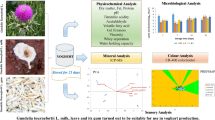Abstract
Ghee production form one of the largest segments of the milk consumption and utilization pattern in India. Recently, cow ghee has become more popular and fetching premium over buffalo ghee as there are innumerable health benefits credit to cow ghee since they contain an important array of nutrients and therapeutic principles. Therefore, the present investigation was conducted to differentiate and characterize cow ghee from buffalo ghee using physico-chemical parameters viz. BR reading, RM value, Polenske value, Kirschner value and different color values. Pure cow and buffalo ghee samples were prepared using creamery butter method. Pure ghee samples (cow and buffalo) and cow ghee samples admixed with buffalo ghee @ 5%, 10%, 15% and 20% were analyzed for above mentioned physico-chemical parameters and different color parameters. The results revealed that BR reading, RM value, Polenske value and Kirschner value of pure cow ghee ranged from 41.87–43.62, 27.5–31.13, 1.30–1.90 and 20.74–24.14 and in buffalo ghee these values ranged from 40.01–43.23, 31.91–39.99, 1.10–1.50 and 26.84–33.96, respectively. The color values i.e. lightness (L), redness(a), yellowness (b), yellowness index (Y) and whiteness index (W) of pure cow ghee ranged from 70.17–81.56, − 14.04 to − 28.96, 59.68–79.31, 74.25–88.92 and 16.07–28.85 and of buffalo ghee ranged from 71.89–83.71, − 1.07 to – 11.92, 1.39–9.61, 5.21–22.46 and 68.74–84.61. BR reading, RM value, Polenske value and L, a, b and Y of cow ghee adulterated with buffalo ghee up to 20% falls within the range of different pure cow ghee samples but whiteness index (W) and Kirschner value of admixed cow ghee (23.91 and 34.86) were having significantly higher values than the pure cow ghee (21.07 and 25.45, respectively). Kirschner Value and whiteness index (W) can be used to distinguish cow ghee from buffalo ghee.
Similar content being viewed by others
Availability of data and material
All the relevant data available is mentioned in the manuscript and no other supplementary data is provided.
Abbreviations
- RM :
-
Reichert-Meissl
- PV :
-
Polenske value
- BR :
-
Butyro-refractometer
- PCG :
-
Pure Cow Ghee
- PBG :
-
Pure Buffalo Ghee
- L :
-
Lightness
- a :
-
Redness
- b :
-
Yellowness
- Y :
-
Yellowness index
- W :
-
Whiteness index
References
AGMARK (1981) Ghee Grading and Marking Rules, 1938 (as amended). Government of India, Ministry of Food and Agriculture, Department of Agriculture, New Delhi
Blasi F, Montesano D, Anglelis M, Maurizi A, Ventura F, Cossignani L, Simontti MS, Damiani P (2008) Results of streospecific analysis of triacylglycerol fraction from donkey, cow, ewe, goat and buffalo milk. J Food Compos Anal 21:1–7
Daniel EV (1977) Study of the changes in milk constituents during the preparation of ghee from sour milk. PhD thesis submitted to Punjab University, Chandigarh.
De S (2010) Indian dairy products.Outlines of Dairy Technology. Oxford University Press, New Delhi, pp 382–466.
FAO (2020) http://www.fao.org/dairy-production-products/production/dairy-animals/en/ (assessed on 08/05/2020)
FSSAI Act (2011) Akalank’s food safety and standards Act, rules and regulation, Akalank publication, pp-40–43
Fox PF, McSweeney PLH (1998) Dairy Chemistry and Biochemistry. Blackie Academic and Professional, London
Ghatak PK, Bandyopadhyay AK (2007) Practical Dairy Chemistry, Kalyani Publisher
IS3508:1966 (2018). Methods of sampling and test for ghee (Butter fat), Indian Standards Institution, New Delhi
Kehar ND (1956) Studies on Fats, Oils and Vanaspatis Division of Animal Nutrition. Indian Veterinary Research Institute, lzatnaga
Menard O, Ahmed S, Rousseau F, Briard-Bion V, Gaucheron F, Lopez C (2010) Buffalo vs. cow milk fat globule: size distribution, zeta-potential, compositions in total fatty acids and in polar lipids from the milk fat membrane. Food Chem 120:544–551
NDDB (2020) http://www.nddb.org/information/stats/milkproindia (assessed on 2/5/2020)
Nozière P, Grolier P, Durand D, Ferlay A, Pradel P, Martin B (2006) Variations in carotenoids, fat-soluble micronutrients, and color in cows´plasma and milk following changes in forage and feeding level. J Dairy Sci 89:2634–2648
Ramesha KP, Divya P (2014) Recent advances in animal genetics for enhancing dairy animal productivity in India, in 42nd Dairy Industry Conference. Indian Dairyman 1:94–100
Rao R, Dastur NN (1984) Association of biliverdin with micellar casein and casein fraction of buffalo milk. Indian J Dairy Sci 37:234–240
Sen-Gupta P N (1943) Importance of Kirschner value in the detection of adulteration of ghee (butterfat). Journal of the Indian Chemical Society (Ind. & News Ed.). 6(3/4): 153–160
Statista (2020) https://www.statista.com/statistics/761768/india-ghee-production-volume (assesed on 08/05/2020)
Suwarat N, Tungjaroenchai W (2013) Characteristic of ghee obtained from different post-clarification temperatures. Int J Biosci Biochem Bioinf 3(4):332
Acknowledgements
Authors are much thankful to the Director of NDRI, Karnal for providing facilities to carry out the research and acknowledge the financial help provided by the National Dairy Research Institute, Karnal, Haryana, India.
Funding
No funding was received.
Author information
Authors and Affiliations
Contributions
Sonia Mor: formal analysis, data interpretation, writing-original draft. Vivek Sharma: Conceptualization, formal analysis, data interpretation, reviewing and editing. Sumit Arora: reviewing and editing. PS Minz: resources, reviewing and editing.
Corresponding author
Ethics declarations
Conflict of interest
The authors have declared no conflict of interest for this article.
Additional information
Publisher's Note
Springer Nature remains neutral with regard to jurisdictional claims in published maps and institutional affiliations.
Rights and permissions
About this article
Cite this article
Mor, S., Sharma, V., Arora, S. et al. Physico-chemical and color parameters to distinguish cow ghee from buffalo ghee. J Food Sci Technol 59, 3231–3236 (2022). https://doi.org/10.1007/s13197-022-05496-z
Revised:
Accepted:
Published:
Issue Date:
DOI: https://doi.org/10.1007/s13197-022-05496-z




